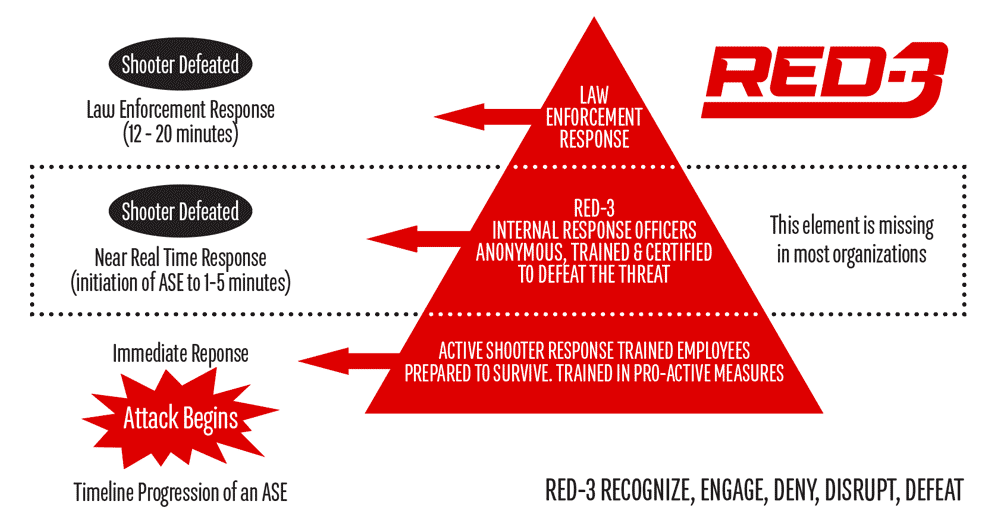
RED3 – The Answer to the ASE Threat
Mitigating Tragedy through Increasing Survivability
RECOGNIZE – ENGAGE – DENY – DISRUPT – DEFEAT
In the last two decades Active Shooter Events (ASE) have increased in frequency and intensity. In 2000 the FBI reported three ASE. However, in the last 20 years there has been 333 ASE with 2020 registering a record 40 in that year alone. While Active Shooter Awareness Training for individuals, schools, and businesses is certainly valuable, a stark reality remains; these catastrophes will continue to occur until the real issue is addressed – Public institutions and private businesses enact response plans that inhibit a rapid and effectual response to an ASE. People are continuing to be left susceptible which requires them to defend themselves from a position of vulnerability
In 2015 the South Carolina National Guard (SCNG) recognized that its personnel were unprotected and instituted a program to address this “position of vulnerability.” The Secure Area Duty Officer Program (SADOP) was approved by Governor Nikki Haley and through collaboration between the SCNG and the South Carolina Law Enforcement Division (SLED) SADOP initiated the training of SCNG personnel. This training enables them to recognize and respond to Active Shooter threats using methods that combine military and law enforcement situational awareness methods and close quarters techniques. The program employs an intensive week-long combat pistol training course that provides evaluated events including challenging day and night firearms qualification courses, timed firearms manipulation skills, written and practical examinations, and competitive firing drills designed to improve response times, speed, and precision.
Though the students who participate in SADOP are members of the SCNG the majority are not combat arms troops, extensively trained in firearms or even assigned a sidearm as their primary military weapon. Most are administrative, logistical or training personnel without previous experience in military or law enforcement individual lethal threat engagement techniques. Even so SADOP graduates routinely refer to the training they received as “the best training they have attended in their career.” Some of the newly trained SADOP Armed Duty Officers who were previously professional police officers have also stated that the SADOP training far exceeded their expectations and qualifies as “advanced level” counter-Active Shooter training.
Barry Ramey and Seth Horrell, both developed SADOP as administrators, training cadre and as Program Managers, and after retiring from the U.S. Army they recognized that corporate America remains defenseless to the Active Shooter threat and is in dire need of just such a program. Furthermore, they understand that the Soldiers they trained really had no more preparatory training than most civilians and that Counter-Active Shooter training principles were not exclusive to the military office worker, training sergeant or mechanic but, was a modular concept well suited for enabling businesses to protect their “human capital” in a manner that empowers them from a position of advantage!
AN ACT OF COURAGE.
Countering an ASE or workplace violence requires an act of courage. It is an act of courage to immediately and effectively respond at the origin of the attack.
It is an act of courage as a business proprietor or partner to create a thorough ASE plan.
- What percentage of your workforce will return to work post-ASE?
- Are there corporate solvency issues related to a poor ASE Response Training Plan?
- Does your company General Liability Insurance Policy cover an ASE?
- Is there a business continuity plan if the facility or offices are closed for weeks or longer?
When your company is inclined to take an immediate and effective act of courage to ensure its continued survivability by providing its employees a solution that could dramatically alter the outcome of a catastrophic events, please contact Dynamic Response Solutions for a vulnerability assessment and consultation.
ANATOMY of an Active Shooter Event
- Five Phases of an ASE
- a. Fantasy Phase
- b. Planning Phase
- c. Preparation Phase
- d. Approach Phase
- e. Implementation Phase
- Failing to identify the Five Phases of an ASE results in:
- a. The attack is initiated
- Run, Hide, Fight DHS Video. The survivor’s current only option is limited to evacuating, hiding from an attacker and hoping not to be discovered, or as a last resort offering physical resistance with improvised weapons.
- b. The 911 emergency call for First Responders go out
- First Responder (Law Enforcement) Response time: Between three to 18 minutes.
- First Responder (EMS / Fire Department Paramedic) Response time: 20-22 minutes.
- Depending on location Law Enforcement will arrive with limited capability statistically after most of the casualties have been caused (the five highest casualty ASE took place despite Law Enforcement arriving on scene in about three minutes).
- b. The 911 emergency call for First Responders go out
- Law Enforcement will make entry with whatever personnel they have onsite to attempt to interdict the threat.
This diagram demonstrates what could happen if an organization has RED3 trained individuals prepared to respond to a deadly threat. Studies show that in the instances that there was someone trained and armed in the vicinity of the shooter the ASE had a significantly positive outcome by comparison to those that did not.
